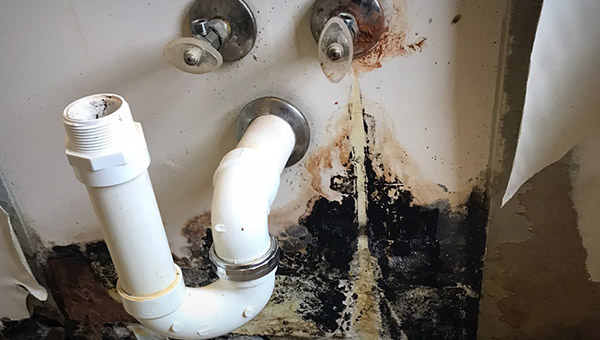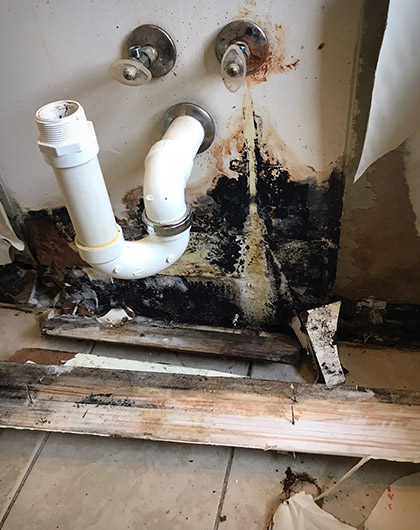
Mold under the sink is one of those hidden household problems that often goes unnoticed until it becomes a serious issue. The dark, damp space beneath your sink is the perfect breeding ground for mold. And once it starts growing in your kitchen or bathroom, or even the laundry room, it can spread quickly, damaging the cabinet and even posing health risks to your family.
If you've noticed a musty smell, discoloration, or warped wood under your sink, you're not alone. Thousands of homeowners deal with this exact issue every year, and many don't realize how important it is to act fast.
At FDP Mold Remediation, we've helped countless homeowners safely remove mold from under sinks and prevent it from coming back. In this guide, we'll walk you through how to identify mold, clean it properly, and know when it's time to call in the pros.
The space under your sink might seem harmless, but it's actually an area of your home that is most prone to mold growth. Why? Because it has all the characteristics that mold needs to thrive: moisture, darkness, and organic material.
Understanding these causes is the first step toward prevention. Regular inspection and maintenance are important to identify mold under the sink as soon as possible.


Mold under the sink often appears as irregular patches that may be fuzzy, slimy, or powdery. It typically grows in corners, along the cabinet base, around plumbing fixtures, or on the back wall, all areas that stay damp and may be poorly ventilated.
You might also notice a musty, earthy smell. This is a strong indicator that mold is present, even if it isn't visible yet.
Tip: If you're unsure whether what you're seeing is mold, take a photo and compare it to online examples, or contact a professional like FDP Mold Remediation for a quick assessment.

Yes! Mold under the sink can be dangerous for your health and home. While not all mold is toxic, even common household strains can trigger allergic reactions, worsen asthma, and cause respiratory irritation. This is especially true for small children, the elderly, or anyone with a weakened immune system.
Mold feeds on organic materials like wood and particle board. Over time, it can weaken the cabinet base, walls, and even spread into surrounding drywall or flooring. If left untreated, it may require costly repairs or even full cabinet replacement.
Mold spores can become airborne and circulate through your home. Symptoms may include coughing, sneezing, skin irritation, headaches, and fatigue. Black mold is known in particular for producing mycotoxins that can pose more serious health risks.
If you or your family are experiencing unexplained symptoms and suspect mold under the sink, it's best to have it professionally assessed. FDP Mold Remediation can help determine the severity and safely remove the mold before it spreads further.

If you suspect mold under your sink, a quick inspection can help you confirm the problem before it spreads further. Here's how to check safely and thoroughly:
If you find visible mold or suspect it's spreading behind the cabinet or into the wall, it's time to take action. FDP Mold Remediation offers professional inspections and can help you determine the safest next steps.

So, you've found mold under your sink. Don't panic. If it's a small patch and you don't see any mold on walls or flooring, you can likely take care of it yourself with a little time and the right approach.
Let's walk through it step by step.
Heads up: If the mold keeps coming back, covers a large area, or smells really strong, it's time to call in the pros. FDP Mold Remediation can safely remove the mold and make sure it doesn't return.
Sometimes, mold under the sink isn't just a surface issue, it can show up in tricky spots or involve materials that make cleanup harder. Here's how to handle a few of the most common scenarios:
Particle board (often used in cabinet bases) soaks up moisture like a sponge. If it's swollen, soft, or crumbling, cleaning won't be enough. Trying to clean mold from damaged particle board won't work, so it likely needs to be removed and replaced.
If you suspect black mold (especially if it's slimy, dark, and has a strong odor), don't try to tackle it alone. Black mold can release mycotoxins that may cause serious health issues. This is a job for professionals like FDP Mold Remediation, who have the tools and safety protocols to handle it properly.
Mold growing on pipes is often caused by condensation. After cleaning the mold, consider wrapping the pipes with insulation to prevent future moisture buildup.
If mold has spread into the drywall behind it or to the cabinet's back wall, the situation is more serious. You may need to remove panels or cut into the wall to fully eliminate the mold. This is another example where professional remediation is the safest route.

Cleaning up mold is only half the battle. The real challenge is keeping it from coming back. Fortunately, a few simple habits and upgrades can make a big difference.
Even a slow drip under the sink can create enough moisture for mold to thrive. Check your plumbing regularly and repair any leaks as soon as you spot them.
Keep cabinet doors open occasionally to let air circulate, especially after using hot water. If your kitchen or bathroom tends to stay humid, consider using a small fan or dehumidifier nearby.
Wipe up spills right away and avoid storing wet items under the sink. You can also place a moisture-absorbing product (like silica gel or baking soda) in the cabinet to help control humidity.
If your cabinet base is made of particle board or untreated wood, sealing it with a waterproof coating can help. In some cases, replacing it with a more moisture-resistant material is worth the investment.
Make it a habit to check under your sink every few weeks. Catching moisture or mold early is the best way to avoid a bigger problem later.

While small patches of mold can often be handled with DIY methods, there are times when calling in a professional isn't just smart, it's necessary.
Here's when you should skip the vinegar and call the experts:
At FDP Mold Remediation, we specialize in identifying and removing mold at the source, not just cleaning what's visible. Our certified technicians use advanced tools to detect hidden moisture, safely remove contaminated materials, and restore your space so mold doesn't come back.
Mold under the sink might seem like a small issue, but left unchecked, it can lead to serious health risks and costly damage. The good news? With the right steps, you can spot it early, clean it up safely, and keep it from coming back.
Whether you're dealing with a minor patch or something more serious, the key is to act quickly and thoroughly. And if you're ever unsure, don't hesitate to bring in professionals who know how to handle it right.
FDP Mold Remediation is here to help, from inspections and cleanup to full remediation and prevention. If you're ready to stop mold in its tracks, contact us today for expert support and peace of mind.



